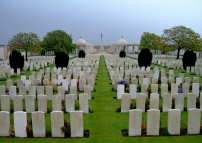| First Name: | Richard Markham | Last Name: | COOTE | |
|---|---|---|---|---|
| Date of Death: | 13/10/1915 | Lived/Born In: | Earl's Court | |
| Rank: | Captain | Unit: | Royal Berkshire8 | |
| Memorial Site: | Loos Memorial, France | |||
Current Information:Age-23 84, West Cromwell Road, Earl's Court The Battle of Loos This battle, fought by the British Army from 25th September, 1915 through to 13th October, was conducted along a six-and-a-half-mile front running north from the mining village of Loos on the outskirts of Lens in Northern France. It was the largest offensive carried out by the British so far in the war. The opening day involved an attack by six divisions, with others entering the fray as it progressed and it was part of a much wider offensive with the French launching their own attacks in Champagne and at Vimy. It was the first time that the British used gas during the war, despite their condemnation of the Germans for doing the same in April 1915. There were some encouraging results on the first day but no major breakthrough was achieved and in the successive days the offensive became mired in trench warfare. By mid-October the battle had petered out with the British having suffered over 60,000 casualties during its course. The last throw of the dice for the British army at Loos came on 13th October, 1915, when there was a renewal of the offensive along much of the line. But this time there were no grand ideas about a breakthrough. The objectives were far more modest and included the recapture of Fosse 8 and the Quarries and the consolidation of the line that ran along the Lens to La Bassée road. The action started at noon with a two hour bombardment of the enemy positions and once again the release of gas. The gas however was ineffective serving only to warn the Germans of the impending attack. When the infantry attack was launched at 2pm 1st Division attacked the new German trench along the Lens Road, north of its junction with the Loos-Hulluch road. 1 Brigade led the attack with all five of its battalions in line, 14th London, 8th Royal Berkshire, 1st Black Watch, 10th Gloucestershire and 1st Cameron Highlanders. They had to cover 300 yards of open ground moving under cover of smoke save for the last 50 yards. Enemy fire from in front and the flanks grew intense but it was the uncut wire that stopped the attack. Only four gaps of approximately 15 yards in width had been blown in it. The supply of grenades wax soon exhausted and when the Germans counter attacked, as they inevitably did, heavy casualties were incurred. As if this was not enough, conflicting messages arrived at Brigade HQ which resulted in the support troops to be sent up. They were unable to even reach the German wire and suffered severely trying to do so. Those who took cover in the long grass fell back under the cover of darkness. The casualties for 1st Division were over 1200 officers and men. The following are extracts from the battalion diary of 8th Royal Berkshire for 13th October, 1915 Precisely at 1:0pm the Chlorine gas discharge began and was continued at intervals until 1:50pm. During this time smoke bombs were thrown out by our men from the front line trench. The wind seemed very favourable and carried the gas and smoke towards the enemy's trench. 1:50PM. The gas discharge ceased, the artillery lifted and the Battalion wire-cutters accompanied by men carrying smoke bombs went forward under cover of the smoke. During the whole time of the smoke discharge hostile machine gun fire from our right flank could be heard. 2:0PM. The remainder of the two companies in the front line went over……. it appears than only about six of these men reached the Estimate (sic) (Estaminet) across the road owing to heavy machine-gun fire from the right flank which seemed to come from the direction of the Chalk Pits….. 2:10PM a report reached me that our first lines had attained the road but were being enfiladed; I then ordered two platoons of the supporting companies to go over. As these men crossed our first line, the Machine Gun Officer, with his team, joined them. This Officer reports that by this time the smoke was beginning to thin and that his team only got about 75 yards beyond our parapet when they came under machine-gun fire and were cut down. From inquiries I have made from NCOs it appears that about fifteen men of this line reached the road but did not cross it. They report that there was little rifle fire from the German trench. Hand grenades were thrown at them from the enemy's trench, but these fell short by about ten yards. 2:20PM. The remainder of the Battalion went over, but were no more successful that the others in reaching their objective. During the night those men who had escaped crawled back to out front-line trench. I Attribute the failure of the attack to the inability of our artillery to silence the German machine-guns, and to the complete absence of support. |
||||
| « Back to Search Results | ||||
| If you think any of the information shown here is incorrect, Click Here to submit your amends and comments | ||||




